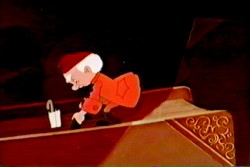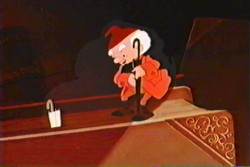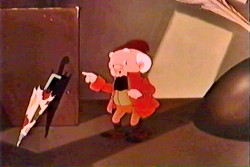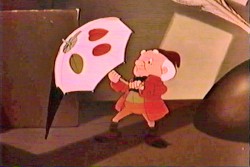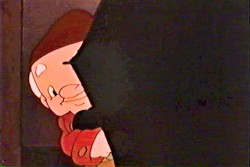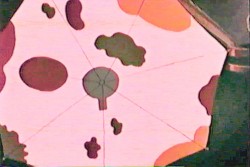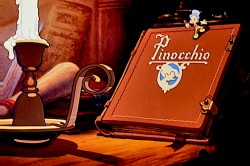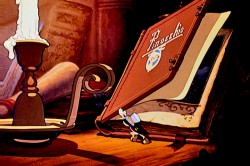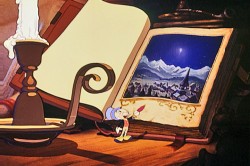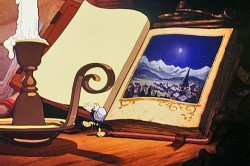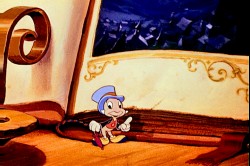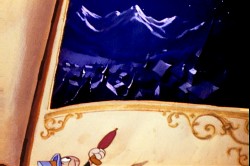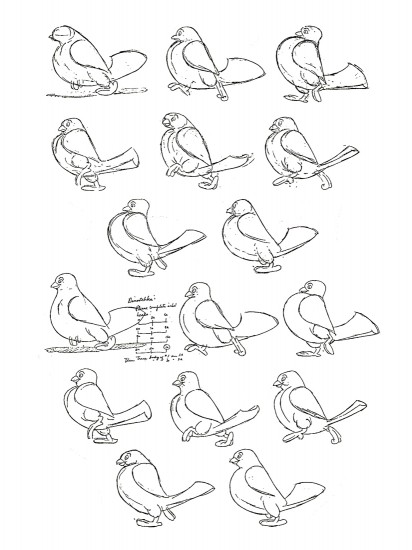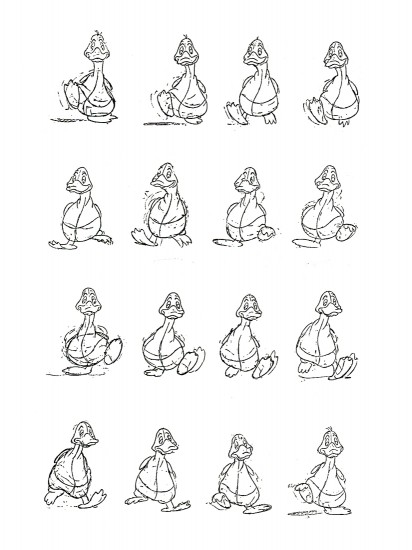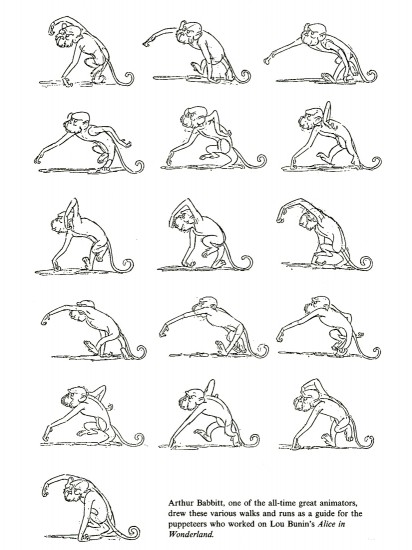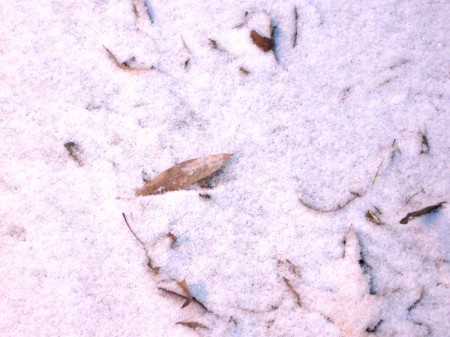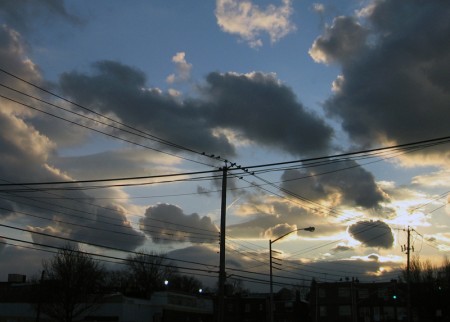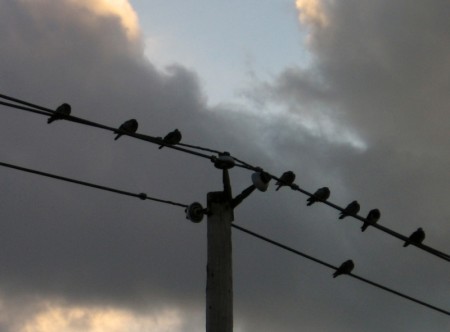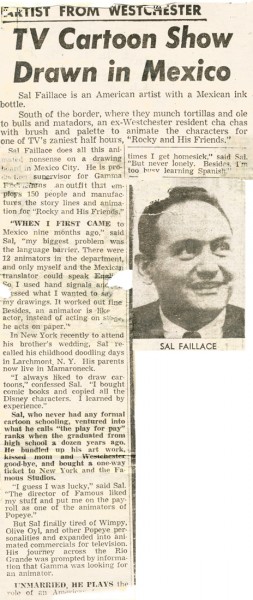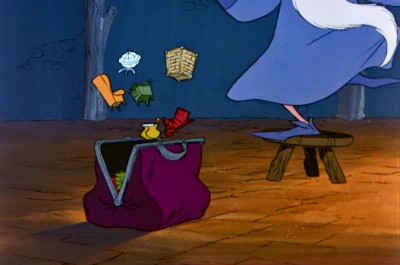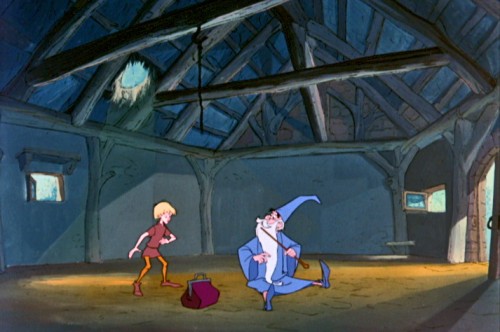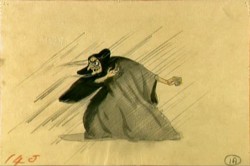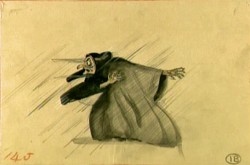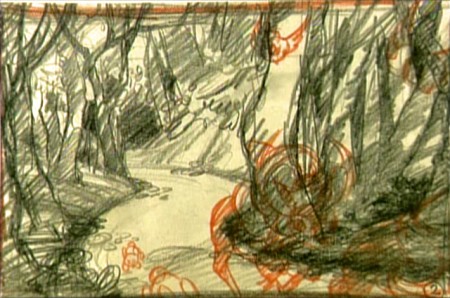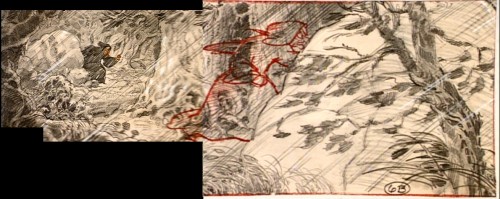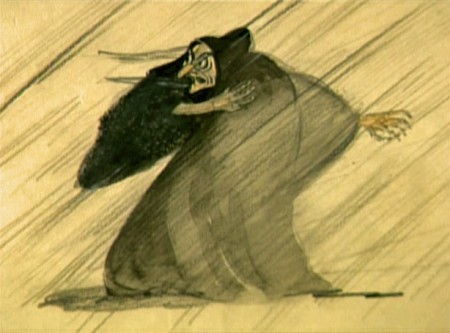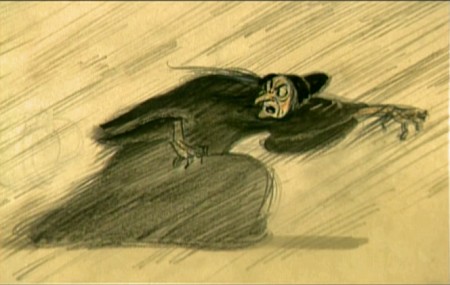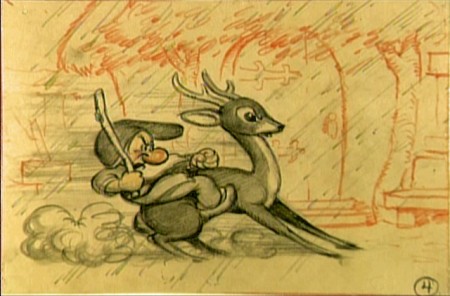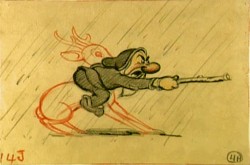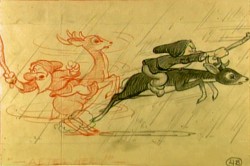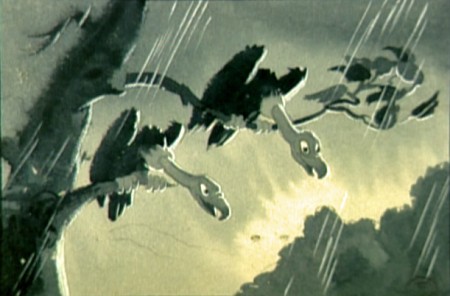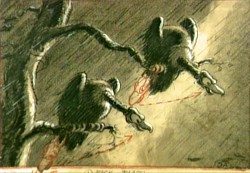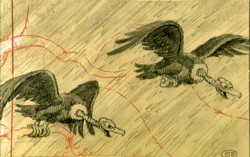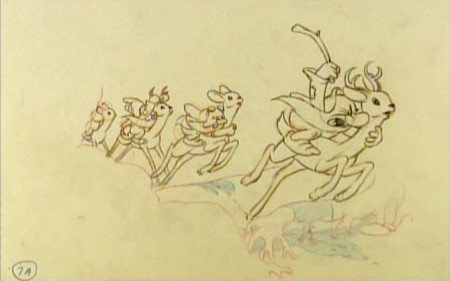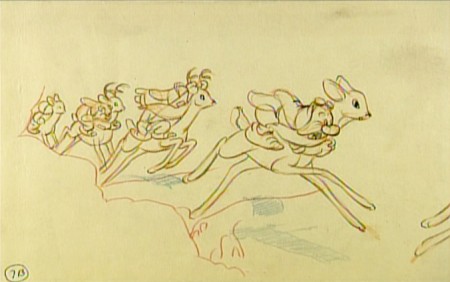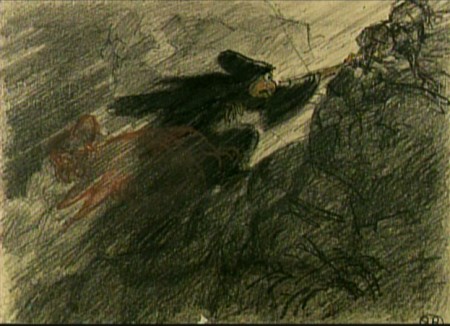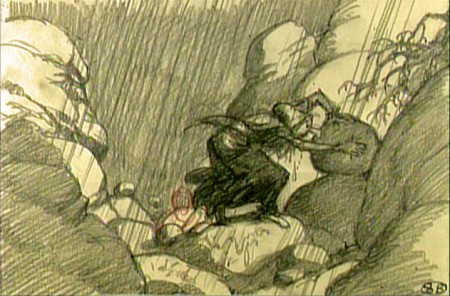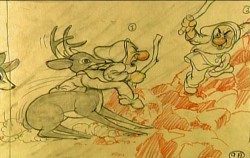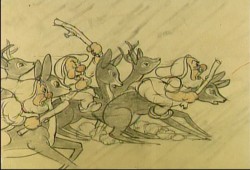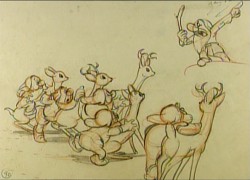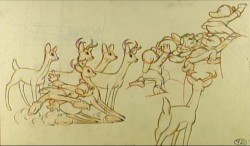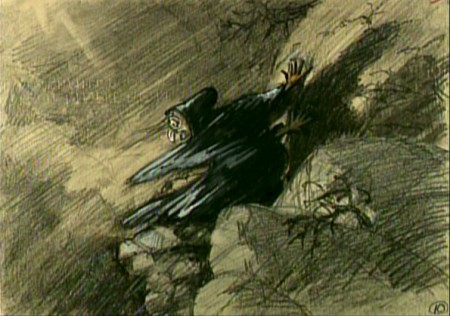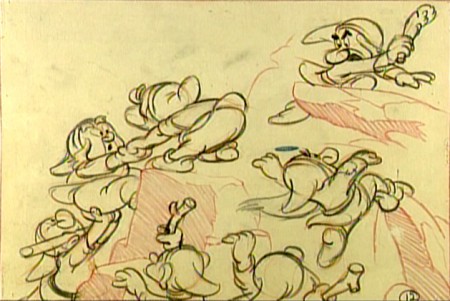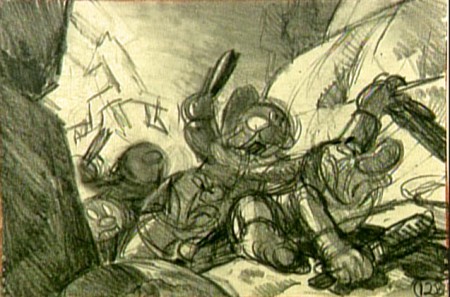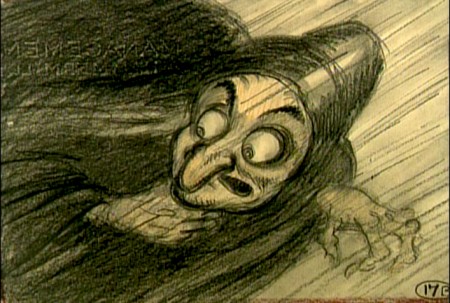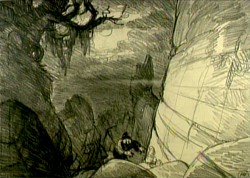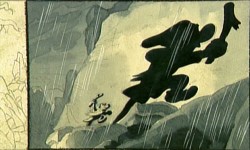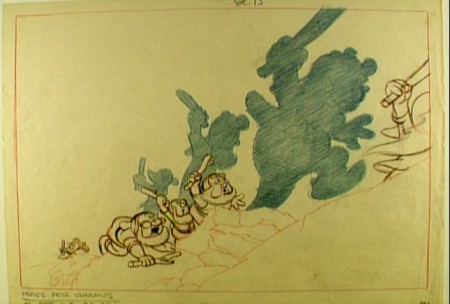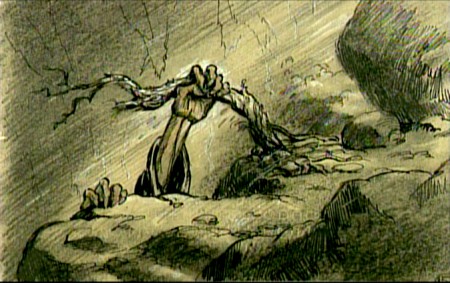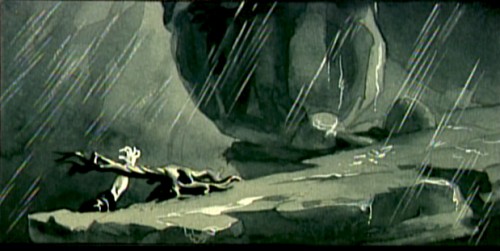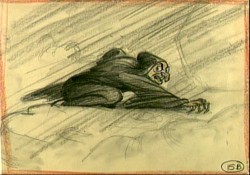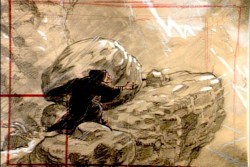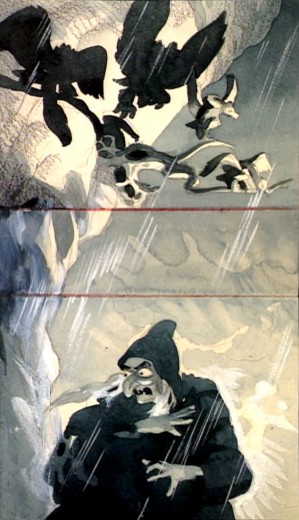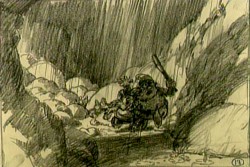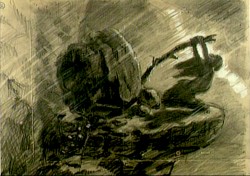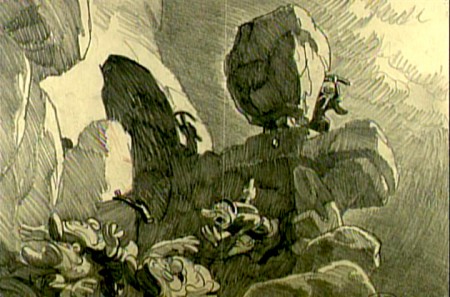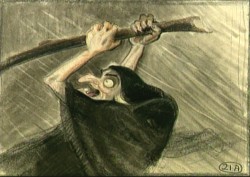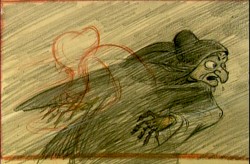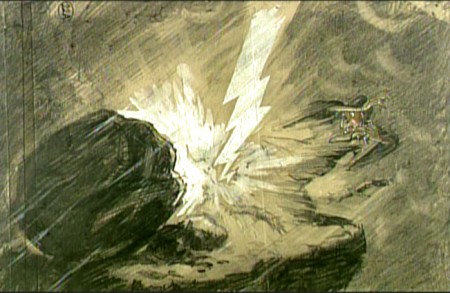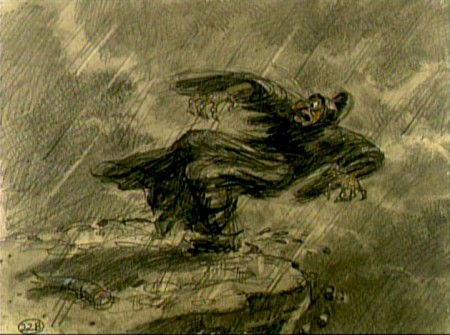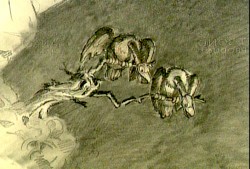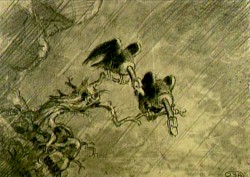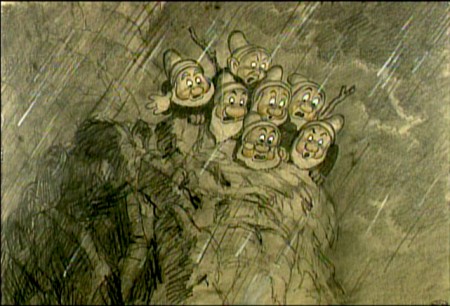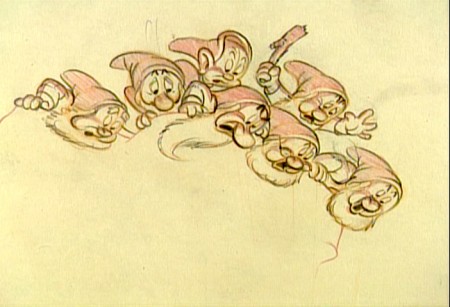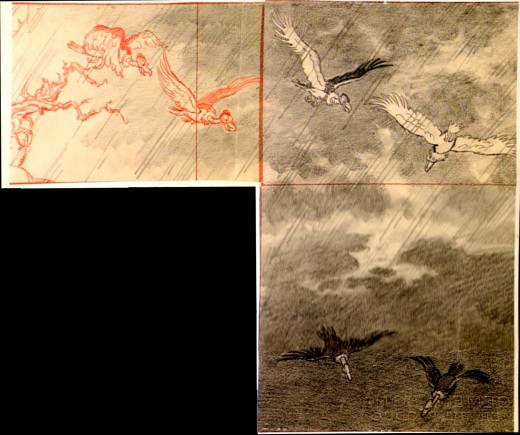Monthly ArchiveJanuary 2009
Commentary &Frame Grabs 21 Jan 2009 08:46 am
“Dreamy” & “Jiminy”
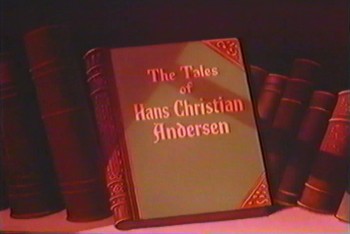 - Back in 1959 Sleeping Beauty wasn’t the only animated feature to hit theaters. Universal had adapted The Snow Queen, a 1957 Soyuzmultfilm production, adding the voices of Tommy Kirk, Sandra Dee and Patty McCormick to the English language version. (Dave Fleischer got credit for “Technical Director” whatever that was.) A new score by the excellent composer Frank Skinner was added including a couple of key songs.
- Back in 1959 Sleeping Beauty wasn’t the only animated feature to hit theaters. Universal had adapted The Snow Queen, a 1957 Soyuzmultfilm production, adding the voices of Tommy Kirk, Sandra Dee and Patty McCormick to the English language version. (Dave Fleischer got credit for “Technical Director” whatever that was.) A new score by the excellent composer Frank Skinner was added including a couple of key songs.
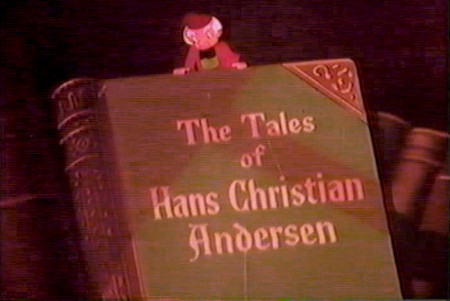
The original Russian film was directed by Lev Atamanov
a significant figure in the history of Russian animation. Several of his films
had been adapted and distributed to American television, including
The Golden Antelope which had received an award of merit at Cannes.
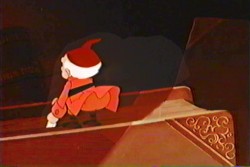
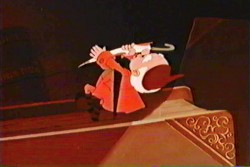
The odd bit about The Snow Queen is that it included an introduction
by a narrator which was voiced by Paul Frees in the English version.
This narrator, calld “Dreamy,” walks around a statue of Hans Christian Andersen
and is flanked by a number of books.
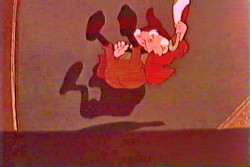
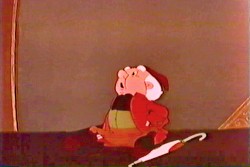
He tells of two umbrellas he used to give Andersen his tales via dreams.
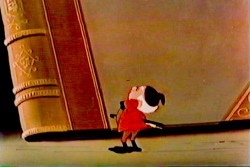
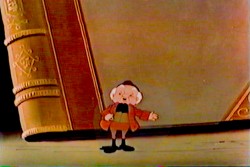
If “Dreamy” waves a black umbrella, Andersen doesn’t dream; if he waves
a colorful umbrella, the dreams are big ones.
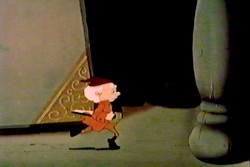
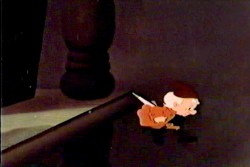
This leads us into the very big dream, “The Snow Queen.”
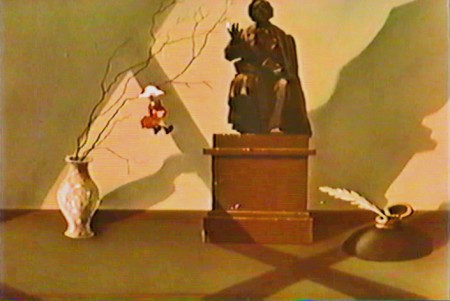
The overall feel of the lethargic and talky piece is that it is very similar
to Jiminy Cricket’s appearance in Pinocchio.
a href=”http://www.michaelspornanimation.com/splog/wp-content/Q/26pan.jpg”>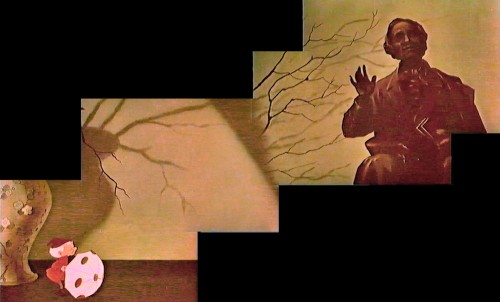
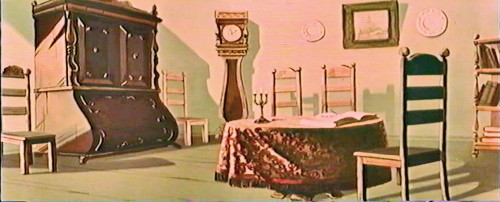
The animation of “Dreamy” was very slow and, I guess, “dreamy.”
You can feel Paul Frees trying to mouth the character’s limited mouth actions
and get all the words into the time allotted. It couldn’t make for a good performance.
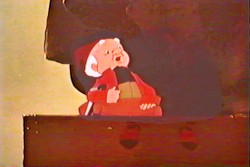
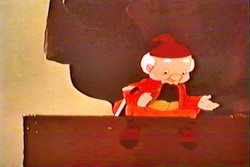
Comparing this to the excellent reading of Cliff Edwards, who mouthed Jiminy Cricket,
the acting in Pinocchio had to, and did, come off better.
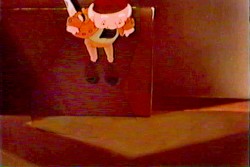
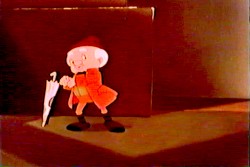
Yet, in saying all this, I have to admit a fondness for “Dremy.” I think it
may be that the film hit me at a very susceptible period in my young life.
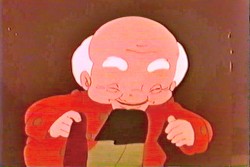
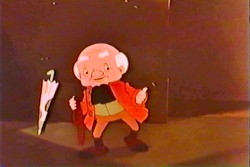
Animated features I saw in this period – I was 12ish – stuck with me.
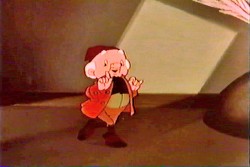
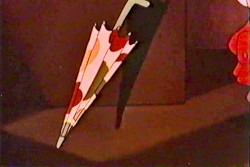
Sleeping Beauty, 1001 Arabian Nights with Mr. Magoo, 101 Dalmatians. They all mean a lot to me and have deeply affected my tastes.
Now let’s take a look at Jiminy’s entrance in Pinocchio.
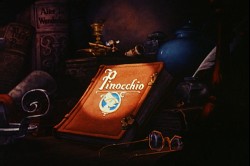
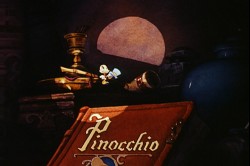
The masters at Disney, by the time they’d made Pinocchio, knew what they had to do.
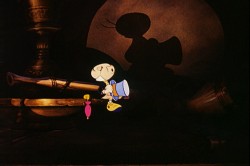
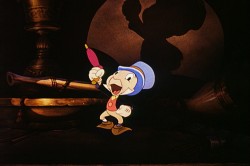
A beautiful song, a great voice with a perfect performance
even though he only had one umbrella.
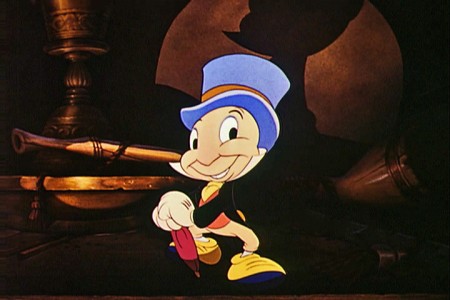
A real character introduced up front in all his glory.
Animation &Articles on Animation 20 Jan 2009 08:50 am
Obama, Borge, Babbitt, Bunin
My favorite post on the subject comes from Tom Sito‘s blog –
as might have been expected.
_______________________________
- I recently received an email from Borge Ring, and thought I’d share its contents with you:
- Back in the sixties I pumped Lou Bunin at Annecy for knowledge about Art Babbitt – “My worlds best animator” at the time – whom I had never met”.
Bunin was friendly and praised Art’s animation for Bunin’s own puppet film about “Alice in Wonderland” but added:
“One thing about him surprised me”,
“What”?
“That he was”such a poor draftsman”
Art animated his scenes on paper for the puppet animator to follow.
Years later I saw a scene from Bunin’s Alice of the rabbit walking up to a door and knocking.
It reeks of Babbitt.
Given this comment, I think it’d be appropriate to post these pages from Shamus Culhane’s book, Animation, From Script to Screen.”
The book includes an enormous wealth of other animation referential material and is a must-own for animation fans. I’d posted two of these two years ago.
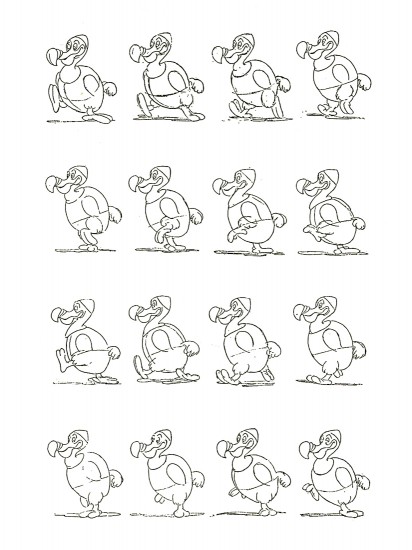
(Click any image to enlarge.)
It’s remarkable that Babbitt was animating for Lou Buinin’s Alice at the very same time his former employer, Disney, was doing their version of the same book. Both films were released almost simultaneously.
Disney, at one point, took Bunin to court trying to suppress his Alice, but the judge sided with Bunin. The material was in public domain.
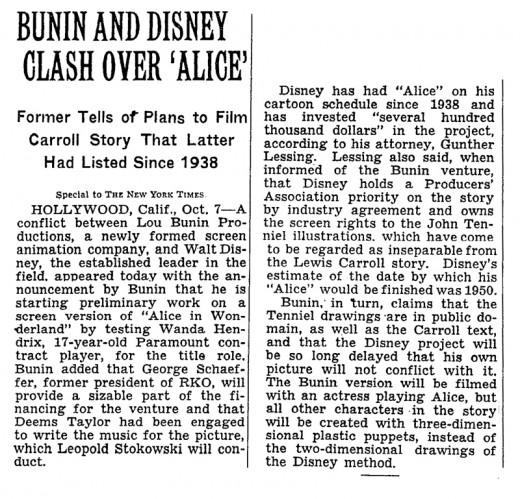
Here’s the review for Lou Bunin’s film:
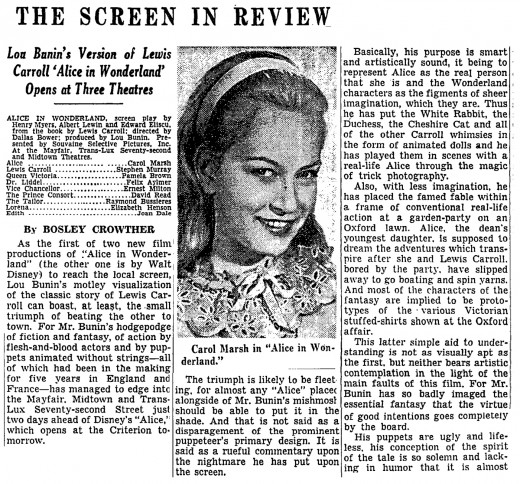
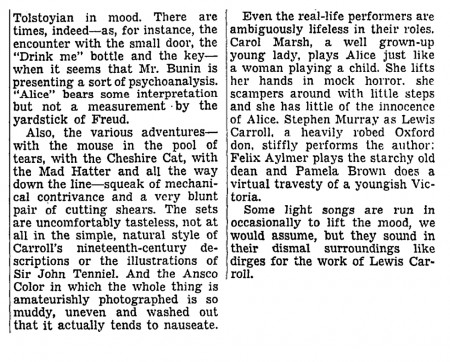
Daily post 19 Jan 2009 08:56 am
MLK, EAP etc.
- Today, of course, is the National holiday honoring Martin Luther King Jr.
It’s impossible to avoid the paradox that this is also the celebration of our first black President’s inauguration. I’ve watched all I could of Obama this weekend and was delighted with the concert held yesterday at the Lincoln Memorial. It’s interesting that the entertainment didn’t feature any of the blockbuster former Mousketeers: Brittany, Christina, Jason, Jessica. Perhaps pop was out.
I am a bit irritated to have to work during the actual ceremony tomorrow. Thank heaven for on line streaming; I’ll be able to view it from my studio on Hulu. I’ll also watch it repeated, undoubtedly, on real tv later tomorrow nite.
Enjoy the day.
Today is also the 200th birthday anniversary of Edgar Allan Poe. The celebrations are smaller but considerable.
- This past Saturday marked the screening/judging in NY of the short listed shorts, both live and animated. There were eight animated shorts totalling about 90 mins of screen time

One-30 min, seven-under 15 min.
Two hand-drawn 2D / six cgi.
One student film, five big budget studio films, two small Independent films.
The nominees will be released on Thursday. Good luck to all of them.
For all but three of the ten live-action shorts death seemed to be the underlying or, in some cases, overriding theme. This made a couple of them wearisome. They were all good, though some were long. There were two or three I might consider exceptional.
The immediate difference between the animated and the live action shorts hit me hard. The live action films felt adult, even the most trite, whereas the animated films seemed cartoonish. They may have had serious themes, but they felt simple in comparison to the adult films. Even my favorite of the animated shorts came across as romantic and somewhat smaller than the best of the live films. It was eye-opening for me. Yet, I’ve often had this experience in watching animated and live action programs back-to-back.
The style of film making is markedly different; the difference is subtle yet obvous, and I haven’t really understood what that difference is. I can think of a couple of animated shorts that felt more complex, like the live films. A good example was Madame Tutli-Putli from last year’s nominees. It was a puppet animated film, and, to me, felt equal if not better than the live action entrants. It was also adult.
This is a theme I’ll have to explore in more depth sometime soon.
- Roy Iddan wrote to ask me to view his latest animated short, calaled Patriot. “Its the story of a veteran of the German army of WWI, Jewish by origin, who finds himself a prisoner in a Nazi German concentration camp during WWII.” The film was financed with a $37,500 grant from the Israel State Lottery. (First Waltz with Bashir, then $9.99, now we’re seeing shorts financed in Israel. This situation is worth watching.)
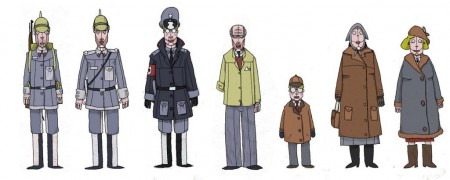
Character model sheet from Patriot.
The film is complex and serious. It moves from B&W to sepia tones to muted colors. It flashes back and forth in time from WWI to WWII without any confusion. No mean feat.
Check it out here.
 My friend, Tom Hachtman pointed me in the direction of this two part interview: One on One with Bill Plympton
My friend, Tom Hachtman pointed me in the direction of this two part interview: One on One with Bill Plympton
with Riz Khan on Al Jazera.
Photos 18 Jan 2009 09:37 am
PhotoSunday – Whatta Thursday
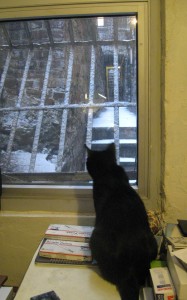 - This past Thursday was an interesting day in New York.
- This past Thursday was an interesting day in New York.
It was a cold day. We woke to a snow storm. Not a bad one, only about 3 inches of snow. It was one of those nice snow falls that left everything white and clean looking, and the snow was just about gone by the time we went home.
We closed the day by hearing about a plane that had to land in the Hudson River after a flock of geese crashed through and destroyed the jet engines. No one was hurt, all the luggage was lost, and the pilot was proclaimed a “hero” – word of the decade.
It was a positive day. As David Letterman said, perhaps this will auger a different and more hopeful year to come. We had our first sample of it when Obama’s candidate for Attorney General told Congress that waterboarding is and always has been “torture” and that Gitmo would be closed.
Here are some pictures of snow in the morning and the skies at night. I took the snowy pics and my friend, Steven Fisher, took the shots in the sky. The pic above is our latest studio kitten, Ian, looking out the window as the snow falls in the alleyway.

Looking West, down Bleecker Street, at 6:30 in the morning.
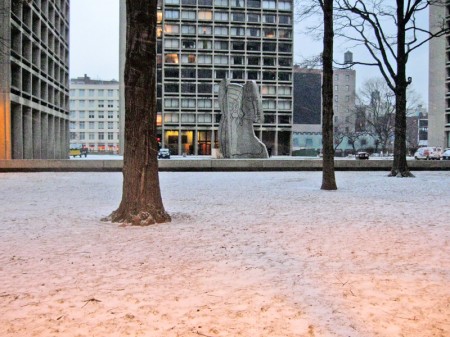
That’s the Picasso statue in front of the NYU housing quarters on Bleecker Street.
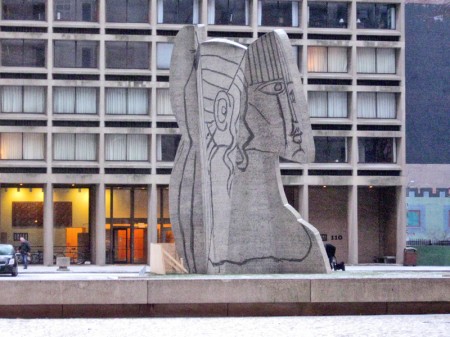
Here’s a closer shot of it. Snow falls lightly, almost invisibly, around it.
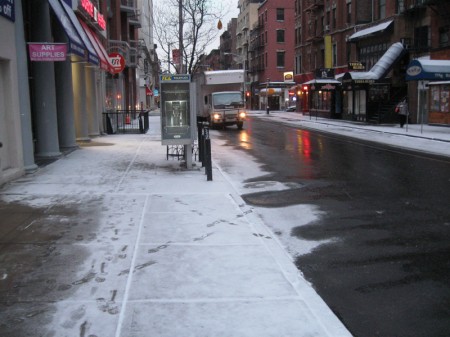
Looking up – East – the heart of Bleecker St.
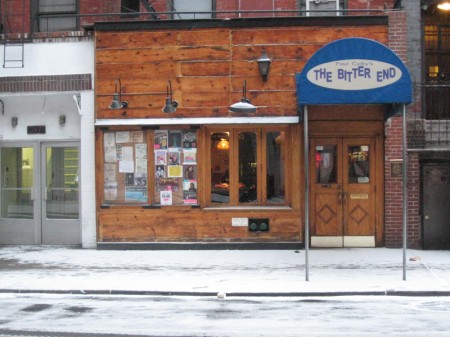
The famed Bitter End, with a slippery sidewalk.

The famed Le Figaro Cafe – oh, wait . . . that’s right
Le Figaro was destroyed to give us a fast food Mexican joint.
History rolls on, despite all the famous people that traipsed through Le Figaro.

Bleecker Street, looking West to the Hudson River. The invisible falling
snow has gotten so heavy it’s hard to get my automatic camera to focus.
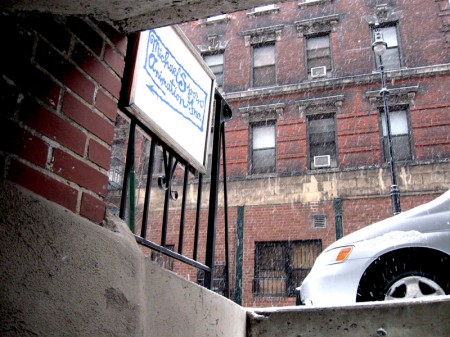
Finally, reaching the studio where the snow was getting heavy but
didn’t show up in many of my pictures. This shot looks up at the sign
as you’d exit the studio, generally banging your head on the brick overhang.
Daily post 17 Jan 2009 09:40 am
There are things
- This video has been around for some time, but it’s new to me so forgive me if it’s old news to you. But 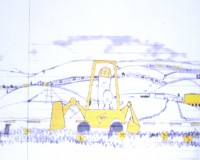 here’s a music video I enjoyed – a lot. It was done at Passion Pictures by Laith Bahrani. The song, JCB, is by the band “Nizlopi” and consists of three extremely long scenes. Lots of work. to pull of something that looks so simple. He talks a bit about this video – for a hit song in England – here.
here’s a music video I enjoyed – a lot. It was done at Passion Pictures by Laith Bahrani. The song, JCB, is by the band “Nizlopi” and consists of three extremely long scenes. Lots of work. to pull of something that looks so simple. He talks a bit about this video – for a hit song in England – here.
And if you don’t look at the JCB video defintiely look at the Radionhead video Bahrani did for their song “Creep“. One scene, the entire piece. Extraordinary work, in my opinion.
You can scan his site, Monkeehub, if you want more.
Cartoon Brew pointed to this post on Sherm Cohen’s site, Cartoon Site. It’s a well illustrated piece on the life work of Dan Gordon. From the Florida Fleischers to the Hollywood Hanna-Barbera, Gordon was there, and he hasn’t gotten the attention he’s deserved.
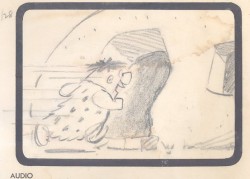
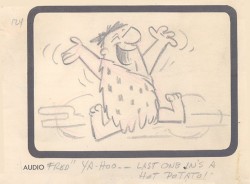
2 Dan Gordon storyboard drawings from the first Flintstones, courtesy of AnimationArtGallery.com
Thanks to Sherm Cohen for writing it and Cartoon Brew for directing me to it.
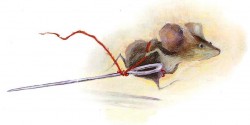 - As readers of this site know, I usually agree enthusiastically with much of Mike Barrier‘s thoughts on animation and film. We have similar opinions – usually. His recent comments on The Tale of Despereaux represents a fine example of our disagreeing. The film is not earth-shatteringly good, but it’s certainly one of the two or three best animated features I’ve seen this year. There’s nothing for it to apologize for.
- As readers of this site know, I usually agree enthusiastically with much of Mike Barrier‘s thoughts on animation and film. We have similar opinions – usually. His recent comments on The Tale of Despereaux represents a fine example of our disagreeing. The film is not earth-shatteringly good, but it’s certainly one of the two or three best animated features I’ve seen this year. There’s nothing for it to apologize for.
I very much like the design styling. It looks as though it were hand drawn (as much as cgi puppets can be), and took its art direction cues from late Middle Ages French artwork. A lot of careful thought was also given to the lighting and the gentle movements of the characters. (No snappy and tedious pose hits in the movement here.) The voice work and music were also fine. It isn’t a great film, but, to me, it’s miles above many other animated films and blockbusters I’ve seen recently.
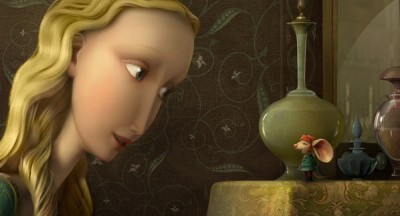 To say that it’s too terrifying to children is, to me, ridiculous. Snow White, The Lion King and Bambi were both made for the same audience – the family. All three of those were certainly violent and more damaging than anything presented in Despereaux. As a children’s film maker, I’m tired of hearing people talk about how upsetting these fairy tale themes are to children. Read Andersen’s “The Red Shoes” (wherein the lead girl has her legs chopped off to stop the shoes from dancing) or “The Little Match Girl” (when she dies frozen in the cold.) Read Perrault’s “Cinderella” (where the step-sisters cut off their toes and heel to fit into the glass slippers) or anything from the Grimm Brothers. It’s all more horrific than what the film makers do in these “children’s films” because the words describe images we create in our minds. We can handle what moves across the screen so quickly, but it’s hard to get those “imagined” ideas out of our heads. And why should we? They didn’t damage our parents or grandparents who actually read this material.
To say that it’s too terrifying to children is, to me, ridiculous. Snow White, The Lion King and Bambi were both made for the same audience – the family. All three of those were certainly violent and more damaging than anything presented in Despereaux. As a children’s film maker, I’m tired of hearing people talk about how upsetting these fairy tale themes are to children. Read Andersen’s “The Red Shoes” (wherein the lead girl has her legs chopped off to stop the shoes from dancing) or “The Little Match Girl” (when she dies frozen in the cold.) Read Perrault’s “Cinderella” (where the step-sisters cut off their toes and heel to fit into the glass slippers) or anything from the Grimm Brothers. It’s all more horrific than what the film makers do in these “children’s films” because the words describe images we create in our minds. We can handle what moves across the screen so quickly, but it’s hard to get those “imagined” ideas out of our heads. And why should we? They didn’t damage our parents or grandparents who actually read this material.
Regardless, Despereaux is not a bad film. I’d prefer looking at it than all of the Madagascars and ugly Shreks, and I preferred it significantly more than I did Wall-E. It’s my opinion, and others have theirs. The film has just gotten too many hits for my taste when it actually improves upon what we’ve seen in animation these past few years.
- Finally, Darrell Van Citters‘ new book discussing, analyzing and honoring Mr. Magoo’s Christmas Carol will be released in the Fall of ’09. It’ll be nice to see this Abe Levitow film get some well deserved attention. I think it’s one of the best adaptations of Dickens’ novella, and it includes some of Jule Styne’s finest songs. By the way, why hasn’t anyone released an album of the music and songs from this film? It’s a gem of a track.
Of course, we got to see 200 reruns of The Grinch this Christmas but no Magoo! There’s a conspiracy going on.
You can read more about the book on the Abe Levitow site.
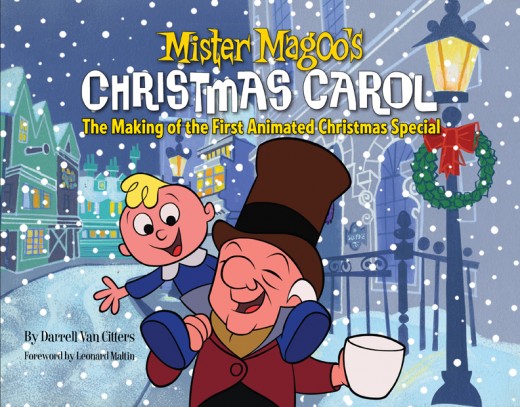
Take a note, Amazon, I’m ready to preorder.
Articles on Animation 16 Jan 2009 09:42 am
NY Makes it Big
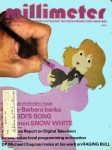 - For as long as I can remember, we, in NY, have been told that the big studio is returning. Again and again we hear that lots of big projects are coming, and we’ll all have to gear up for the glory days. I saw this with Raggedy Ann & Andy; I heard this with Shamus Culhane studio’s Noah’s Ark series of 1/2 hours (before he skipped town to do them in Italy.) It was obviously happening with the advent of Doug, and then MTV, or Courage the Cowardly Dog, or whatever.
- For as long as I can remember, we, in NY, have been told that the big studio is returning. Again and again we hear that lots of big projects are coming, and we’ll all have to gear up for the glory days. I saw this with Raggedy Ann & Andy; I heard this with Shamus Culhane studio’s Noah’s Ark series of 1/2 hours (before he skipped town to do them in Italy.) It was obviously happening with the advent of Doug, and then MTV, or Courage the Cowardly Dog, or whatever.
It always seems to get back to a few smallish studios (like mine) doing individual work. That’s jsut the way it is.
Here’s an article John Canemaker wrote for Millimeter magazine back in January 1981 (a year after I’d formed my studio.)
Return of “Long” Cartoons
by John Canemaker
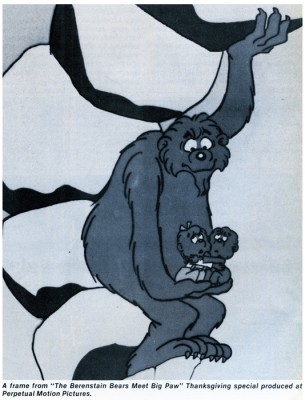 Recently, New York’s animation industry has been enjoying the flattering attention of the television networks in the area of TV specials and series. Last year, three animated prime-time specials and one Saturday morning series (live-action with animated segments) were produced in the Big Apple. With three specials currently on the drawing boards at one studio, and proposals for “longer” shows being prepared by several other local houses, it appears the East Coast, particularly New York City, is witnessing a new and healthy growth in television cartoon production.
Recently, New York’s animation industry has been enjoying the flattering attention of the television networks in the area of TV specials and series. Last year, three animated prime-time specials and one Saturday morning series (live-action with animated segments) were produced in the Big Apple. With three specials currently on the drawing boards at one studio, and proposals for “longer” shows being prepared by several other local houses, it appears the East Coast, particularly New York City, is witnessing a new and healthy growth in television cartoon production.
Busiest and one of the largest of the New York studios is 12-year-old Perpetual Motion Pictures, whose 1979 half-hour NBC special, “The Berenstain Bears’ Christmas Tree,” was the fifth highest rated out of 70 specials that year. The show’s success led to 1980′s “The Berenstain Bears Meet Big Paw,” aired during the Thanksgiving holiday, and a repeat of the Christmas show. This spring will see “The Berenstain Bears’ Easter Surprise” and in 1982, “The Berenstain Bears’ Comic Valentine.” In addition, Perpetual Motion is producing a special which may develop into a series, “Strawberry Shortcake in Big Apple City,” as well as its usual 60 to 70 commercials each year.
Zander’s Animation Parlour, which occupies two floors in midtown Manhattan and (as its ads say) has been “keeping the nicest company for 10 years,” managed to produce its annual load of commercials (close to 100) while producing the hour-long special, “Gnomes, “based on the best-selling picture book, for CBS/Tomorrow Entertainment.
The well-established Kim & Gifford Productions Inc. also completed a full complement of titles and commercials while producing the animation for the NBC kidvid series, “Drawing Power,” produced by the creative team of George Newall and Tom Yohe. “Drawing Power,” the only new entry in Children’s Programming on NBC’s line-up of Saturday daytime programs last fall, was Newall and Yohe’s first series, although they previously produced “Schoolhouse Rock” cartoon inserts for ABC and “Metric Marvels” for NBC.
Exploring the significance of increased production
Buzz Potamkin is the 35-year-old president of Perpetual Motion Pictures. He is fond of quoting Pasteur’s, “Chance favors the mind that is prepared” to explain his studio’s dominance in the production of East Coast cartoon specials. “My partner, Hal Silvermintz, and I decided back in the early ’70s that we wanted to get into the programming area. So when opportunities arose, we took advantage of them.” Perpetual produced animated segments throughout the last decade for NBC’s “First Tuesday,” “Grandstand” and “Weekend,” among other shows.
Potamkin acknowledges a “strong negative reaction against New York City about 10, 15 years ago” on the part of TV programmers. “First, the rise of the TV commercial industry in New York required a different production flow than animated series produced on the West Coast. From a production point of view, more care than is necessary is put into a commercial. The best people went into commercials because the money was good and that was the market available in New York City. There were a few shows done in New York 10 or 12 years ago, but they were not done well—bad scripts, the wrong people working on them, not enough money, wrong concepts. And because there were so few of them done in New York, it became axiomatic that if you do it in New York, it’s going to be bad.
“Secondly,” continues Potamkin, “Hanna-Barbera had discovered a way to produce animation less expensively. That spread like wild-fire through the West Coast, so the West was being set up to produce less expensive, longer animation, and the East Coast to produce short-form, more expensive animation. And the labor pool followed that. We still have a local labor pool of perhaps 300 people as compared to 2500 people on the Coast.”
Jack Zander, who started in the animation business in 1931, recalls network negativity about the smaller New York talent pool. “A lot of people said you can’t make a long film in New York because there are not enough good animators. I said that’s not true!”
Potamkin feels the turning point in this attitude came about three years ago. “The West Coast,” he explains, “became overloaded. With the networks pushing back their pick-up dates for Saturday morning to such an extent, for that six-month period that there was work on the West Coast, you literally couldn’t fit a special in anywhere.”
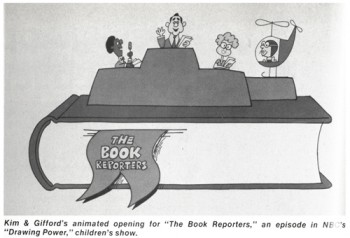 Network producers began to compare the quality of East and West Coast animation, and as Zander points out, “some commercial clients expressed the opinion that the California group of animators has been working so long on Saturday morning stuff that all their animation looks alike.”
Network producers began to compare the quality of East and West Coast animation, and as Zander points out, “some commercial clients expressed the opinion that the California group of animators has been working so long on Saturday morning stuff that all their animation looks alike.”
Potamkin agrees: “With the tremendous footage requirements per week, a lot of very good West Coast animators forgot how to animate. They have difficulty getting back into fuller animation. The networks became aware of this as their specials tended to drop off in quality level.”
“New York animation,” begins Tom Yohe of “Drawing Power,” is just crisper. There is something about the formula look to Saturday morning animation done’on the West Coast—a tendency on the Coast to take a budget and figure if you have so much a minute, that comes out to three drawings a second, or whatever. I think budgets are utilized in a much more thoughtful way by New York animators, like Kim & Gifford’s Al Eugster. Here you have a scene of limited animation or a pan across something, then in another scene you heavy-up the animation. So the overall feeling is more properly paced and gives you a feeling of fuller animation than you get from the formula stuff coming out of most West Coast studios.” I Lew Gifford adds, “There’s plenty of I talent around New York. Often East Coast animators go west for work. I can see the West Coast animators coming here under the right circumstances.”
More studios available.
Another factor in New York’s favor is I the current availability of New York studios with the physical space and personnel necessary for the production of longer films. Zander cites “relatively cheaper costs in L.A. in terms of film footage and work space. And people at the networks are impressed by the space in L.A. Big rooms with lots of people sitting in them—it is important.” Potamkin agrees. “For the first time in 10 years,” he says, “two studios grew up in New York, Perpetual and Zander’s, that were large enough for someone to say, ‘we can trust them with a project this size.’ We’re not four guys sitting in an office somewhere.”
“Perpetual was being forced to consider having to relocate its studio out of New York because of the difficulty in finding a suitable studio area,” comments Nancy Littlefield, head of the New York City Mayor’s Office of Motion Pictures and Television. Potamkin acknowledges that the City’s support was especially helpful “when it came to negotiations over the space—having a couple of people from the City call the landlord and say we don’t want you to lose money, but we really want these people to stay here.” Perpetual moved into its new 11,000-foot space last June with a 10-year lease and Potamkin adds, “We intend to stay here.”
Under Potamkin’s supervision, Perpetual’s “Big Paw” special required one board and track director, one animation and layout director, five animators, six assistant animators, six in-betweeners, a production coordinator, three checkers, two Xerox operators, 20 opaquers, a camera service and so on, through other divisions in the studio’s staff of 67 full-time employees.
Zander’s Animation Parlour normally staffs about 25, plus freelancers, but hired about 85 for the “Gnomes” special. Lew Gifford of Kim & Gifford estimates he has a dozen on staff, but added six or seven animators when his company was preparing the animation for the Saturday morning series, “Drawing Power.” “We have been successful,” he points out, “in not raising the amount of space we have. For a six-to-eight-month run, you don’t want to raise your space.” He notes that the Astoria studio facility in the New York borough of Queens “has space for both live action and animation, and that’s a possible space factor for expansion of facilities.”
The bulk of the preparation for “Drawing Power” came from its two energetic young producers, George Newall and Tom Yohe. “We had a tight schedule,” recalls Yohe. “We got a very late pick-up at the end of April for an October 11 premiere.” Newall adds, “When we got the order, we just started working night and day. Never having done it before, and not even sure we could do it, we worked a lot harder than we might have.”
The informational series takes place, interestingly enough, inside an animation studio. “The show needed animation to be competitive on Saturday morning,” Yohe explains. “We were very lucky in regard to the crippling SAG strike; in six or eight weeks we had all our tracks written and recorded and to the animators before July, so we beat the strike. The live action was under an AFTRA contract; we shot tape during daytime, so we were able to stay in production right through the summer when a lot of guys had to close down.”
Yohe figures that one reason they were able to produce “Drawing Power” without taking on a large staff “is the segments of animation are short—none lasts more than 45 seconds.” The cost of the animation was “in the $7000 per minute range, without tracks.” There were 12 shows containing 10 minutes of live action, with about 14 minutes of animation per show at a cost of about $150,000 per show, or “equivalent to what Hanna-Barbera gets.”
No immediate profit
The half-hour specials of Perpetual Motion are budgeted roughly in the $400,000 range, according to Potamkin. “But costs are inching up now to about $450,000 per. All network shows have relatively me same budget because that is what is available to be spent. Frequently that’s more than the networks are willing to spend! Making specials is not as immediately profit-oriented as making commercials. With commercials, you know what the profit is going to be. With shows, that is not true. The profit doesn’t exist up front. The chances of someone paying $750,000 for a half-hour special in today’s market is very, very unlikely. One has to accept the reality that you’re going to make less money. A lot of people in this business of animated commercials don’t want to accept this.”
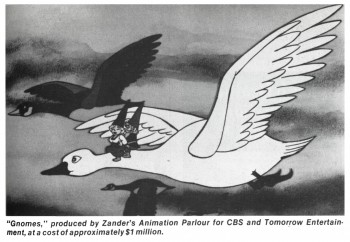 Zander’s “Gnomes” had costs that “hovered around one million bucks, which,” says Zander, “is a lot of money for an hour show. The standard rate for an hour special is $750,000, but CBS and Tomorrow Entertainment threw in some extra money and brought it up to the point where we could do something with it.” The 48-minute, 16-second special took almost two and a half years to see completion. Explains Zander, “It took a year or two to get a good story. The script had to be redone. After that, there was still a year’s work in animating.”
Zander’s “Gnomes” had costs that “hovered around one million bucks, which,” says Zander, “is a lot of money for an hour show. The standard rate for an hour special is $750,000, but CBS and Tomorrow Entertainment threw in some extra money and brought it up to the point where we could do something with it.” The 48-minute, 16-second special took almost two and a half years to see completion. Explains Zander, “It took a year or two to get a good story. The script had to be redone. After that, there was still a year’s work in animating.”
Zander believes that for half-hour specials, “money is not too hard to come by if you find a good property.” But he speaks candidly about the dangers of “animators almost pricing ourselves out of business. We’ve just signed a new contract with the union [Motion Picture Screen Cartoonists, Local 841]. Really, the wages are going up pretty steep. Minimum for an animator is close to $550 per week, and categories below that have come up, too, like inkers, painters getting about $250 per week.
“One time,” recalls Zander, “we had a separate contract for long films. Now in my mind, if you guarantee a person work for a year at $400 a week or whatever, that’s better than working catch-as-catch-can for $600. And it makes it more appetizing for somebody to invest in a film. I think,” continues Zander, “applying commercial rates to feature films is not going to help us. We do a half-minute commercial now for about $20,000. Multiply that by 30 minutes. That makes animation an awfully expensive medium! If we are now seriously considering bringing longer films back to New York, and they are considering us, we’re going to have to work out a different contract.”
Interest in longer films
Indications are that the opportunities to do longer films in New York will continue to occur. “I think the reputation of the City has shifted,” claims Potamkin. “Doors closed to us are now open. People are more willing to talk to us now. I’m sure Jack (Zander) is having the same experience. And they’re not just talking to us as a production office, where work is shipped toL.A., Japan, Europe, but produced right here in NeW York. I know the union is very Happy abouht, lopuhtmildly.”
“The day after ‘Gnomes’ was shown,” recalls Zander, “I got three phone calls from people who have properties they want made into specials. I’m interested, despite the hard work, because, first, it was a lot of fun. Very gratifying, too. I personally put in time on weekends. I enjoyed the challenge and my staff did, too!”
“I don’t know if it’s a trend,” points out Yohe. “I think the networks are happy with the animation they’re getting from us. We’d like to do an animated special at this point. We have things sitting on desks at the three networks, but it’s so unpredictable. They do have an interest in having production done here. It’s also very nice for the children’s programming people here to be able to pop in and look at things without a trip to the Coast.” Newall adds, “We’ve been in business for three years and have yet to set foot in California. And now that the air fares are going up, we’re even less likely to go!”
Lew Gifford finds that “there’s a lot more fun in doing things that you can continue for a long period of time, providing they’re of high quality. There is still a great deal of fun, in solving problems for advertising agencies, but it’s not the same thing as doing an entertainment.
“In the commercials business, you’re lucky if you can look two months ahead. The significant difference,” Potamkin states, “is that instead of being tactical planners where we plug up the dikes and the anxiety about how long the work is going to last, now we can get into strategic things—two we’re finishing, roll over, do one more, plus commercials. What should we do after that? Who should we be talking to? How do we want to bring our younger people along, which we’ve always had a commitment to doing?”
Potamkin has every right to feel confident and secure about his studio’s future in animation produced in New York. “For the first time,” he states “since Hal Silvermintz and I opened this studio 12. years ago, we can look a year ahead and know—bottom line minimum—the work that we have. For a year,” he emphasizes.
Animation Artifacts &Articles on Animation &Commentary 15 Jan 2009 08:52 am
Scrapbook Bullwinkle
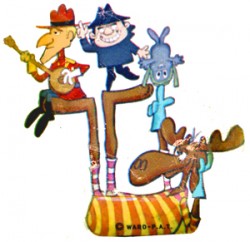 - When I was young, there was little in print about animation. So I kept my eyes open for every newspaper or magazine piece I could find about the subject and I put it in a scrapbook I kept.
- When I was young, there was little in print about animation. So I kept my eyes open for every newspaper or magazine piece I could find about the subject and I put it in a scrapbook I kept.
The Flintstones debut, the opening of 101 Dalmatians, Mr. Magoos 1001 Arabian Nights, Gay Purr-ee, Dick Tracy, The Wonderful World of Color were all projects that generated some publicity – not like you see today, but some. I collected all I could find.
That scrapbook is in storage somewhere, and I won’t find it for a while. However, I do have a couple of pages that seem to have fallen out. This covers the premiere of The Bullwinkle Show on NBC – just prior to Disney’s World of Color show. None of it is pertinent to anything, and all of it is in lousy condition. Regardless, here are a few pieces including the only review I could find – from the NYDaily News. Remember there was no internet, no way to research papers outside of the ones your parents brought home or you could find in the library. This was all material that I had access to.
In advance, I apologize for the condition of these images. They were well read within a roughly assembled scrap book, and they have seen the battlefield of use.
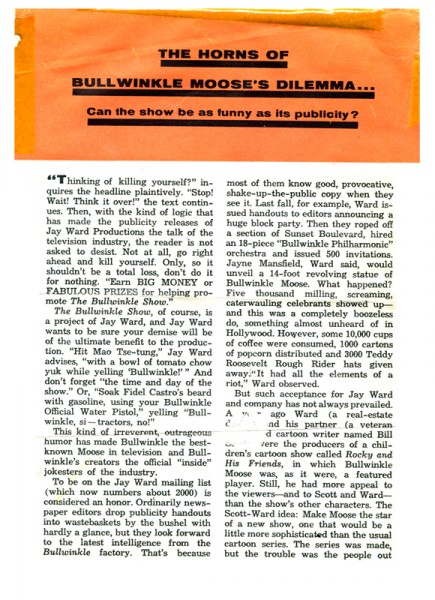
This article (above & below) comes from an issue of TVGuide just prior to the start of The Bullwinkle Show in primetime. Jay Ward fashioned a big and entertaining publicity campaign to get his show on TV and to keep it there. The article discusses this PR aspect of the show.
You can get more information from Keith Scott‘s excellent book,
The Moose That Roared.
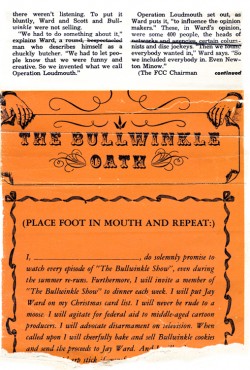
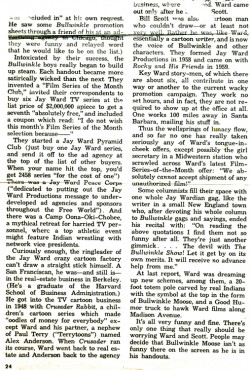
(Click any image to enlarge to a readable size.)
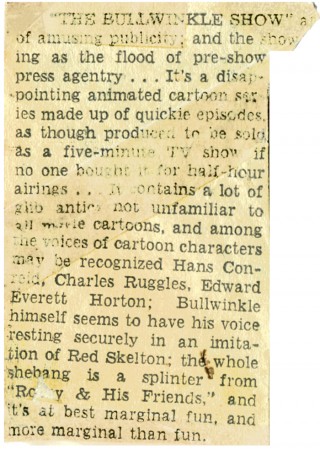
This negative review came from The NYDaily News.
Most of it is legible here.
The gold, for me, came one Sunday in the Westchester edition of The Daily News.
My family was on its regular Sunday summer outing at a New Jersey beach. I came upon the article and spent most of the day reading and rereading it in the sun. I didn’t realize that Sal Faillace was just a local boy with a local news story.
Years later, I got to assist Sal at Phil Kimmelman‘s PK&A studio. I can remember that he animated a bouncing basketball with NO stretch or squash. A hard circle moving “bouncing” around the screen. I was disillusioned in Sal’s work until I actually saw it on film. He really had somehow captured the weight and feel of the basketball without the obvious approach most animators – including myself – would have taken.
I’m sorry I didn’t really spend much time talking with him or asking him about his work at Gamma Productions in Mexico.
Disney &Frame Grabs 14 Jan 2009 08:43 am
Sw in St – Sq.002 cont.
- Continuing with the follow-up to Hans Perk‘s generous posting of the draft to Sword In The Stone, we have Merlin’s song in the sequence wherein Merlin meets Wart, and we get to know them both.
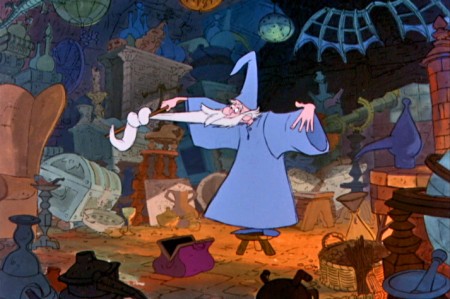
Sq. 002 Sc 125 – Animator: Frank Thomas
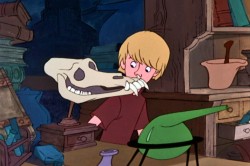
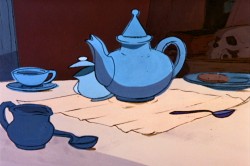
Sq. 002 Sc 126 – Animator: Frank Thomas/Art Stevens | Sq. 002 Sc 127 – Animator: Les Clark
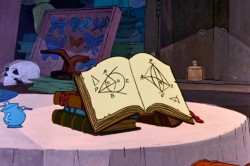
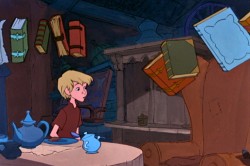
Sq. 002 Sc 128 – Animator: Les Clark | Sq. 002 Sc 129 – Animator: Les Clark
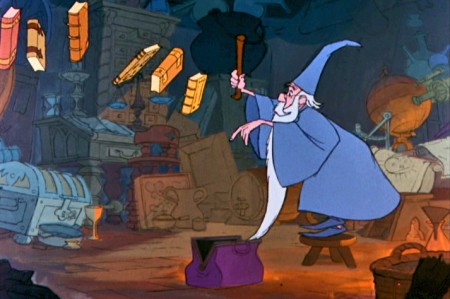
Sq. 002 Sc 130 – Animator: Frank Thomas / Les Clark
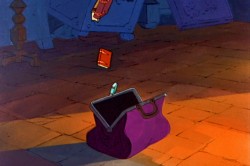
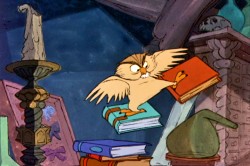
Sq. 002 Sc 131 – Animator: Les Clark | Sq. 002 Sc 132 – Animator: Frank Thomas
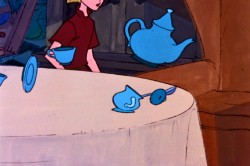
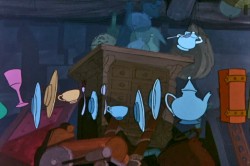
Sq. 002 Sc 133 – Animator: Frank Thomas | Sq. 002 Sc 134 – Animator: Frank Thomas / Dan Macmanus
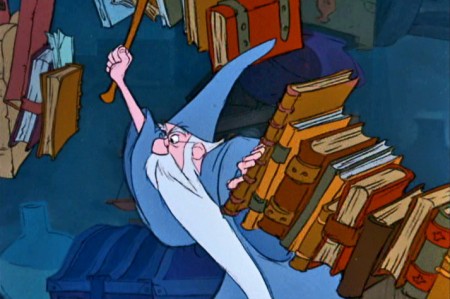
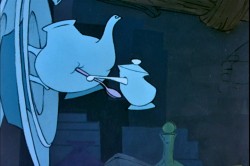
Sq. 002 Sc 135-6 – Animator: Frank Thomas | Sq. 002 Sc 137 – Animator: Les Clark
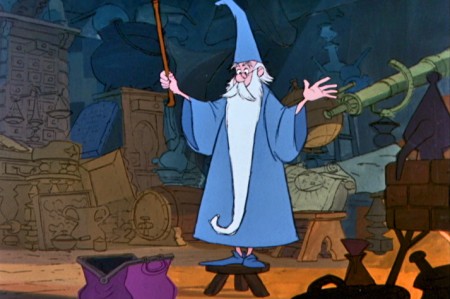
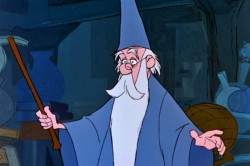
Sq. 002 Sc 138 – Animator: Frank Thomas | Sq. 002 Sc 139 – Animator: Frank Thomas
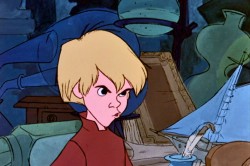
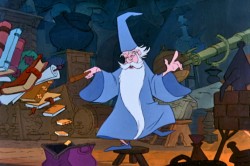
Sq. 002 Sc 140 – Animator: Frank Thomas | Sq. 002 Sc 141 – Animator: Frank Thomas / Dan Macmanus
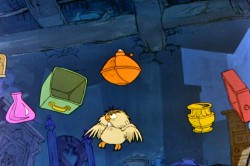
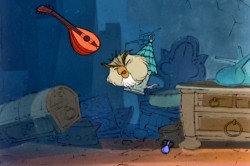
Sq. 002 Sc 142 – Animator: Les Clark | Sq. 002 Sc 143 – Animator: Frank Thomas
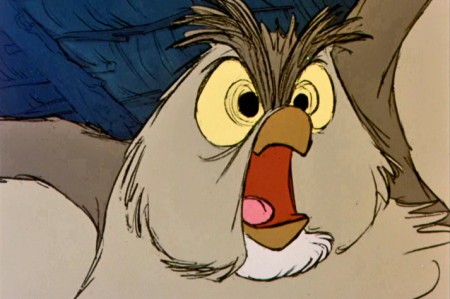
Sq. 002 Sc 143.1 – Animator: Frank Thomas
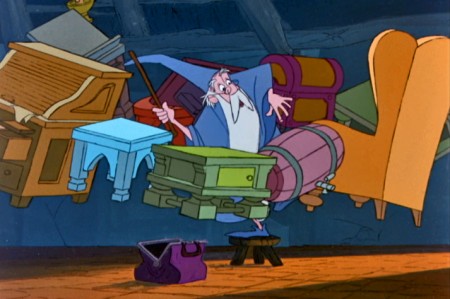
Sq. 002 Sc 144 – Animator: Art Stevens
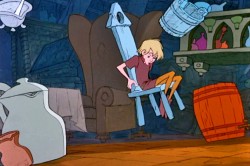
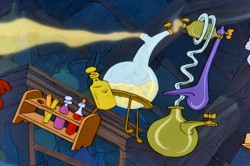
Sq. 002 Sc 146 – Animator: Frank Thomas/Art Stevens | Sq. 002 Sc 147 – Animator: Art Stevens
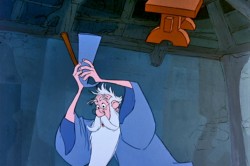
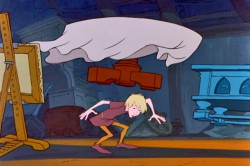
Sq. 002 Sc 148 – Animator: Frank Thomas/Art Stevens | Sq. 002 Sc 149 – Animator: Art Stevens
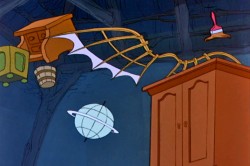
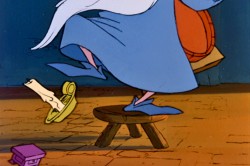
Sq. 002 Sc 150 – Animator: Art Stevens | Sq. 002 Sc 151 – Animator: Frank Thomas/Art Stevens
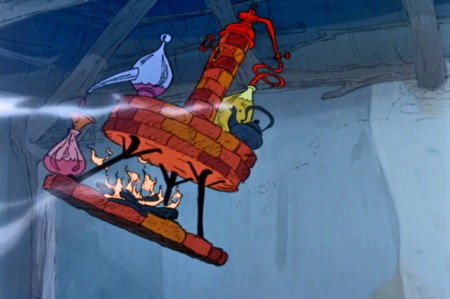
Sq. 002 Sc 152 – Animator: Art Stevens
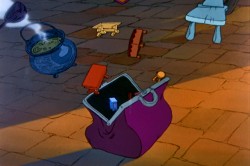
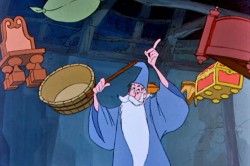
Sq. 002 Sc 154.1 – Animator: Frank Thomas | Sq. 002 Sc 155 – Animator: Frank Thomas/Art Stevens
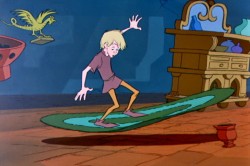
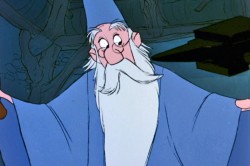
Sq. 002 Sc 156 – Animator: Frank Thomas/Art Stevens | Sq. 002 Sc 157 – Animator: Frank Thomas
The sequence continues, according to the drafts, but this is where my mosaic attempt and interest ends for now.
Disney &Frame Grabs 13 Jan 2009 09:18 am
Sw in St – sq.002
- I mentioned, several days ago, that Hans Perk is currently posting the drafts for Sword In The Stone on his blog, A Film LA. I also mentioned that I liked the opening sequence wherein Merlin and Wart meet. Without trying to do a mosaic for an entire film (as Mark Mayerson has done – I don’t have the fortitude), I have put together these frame grabs for that sequence and the song that follows. It gives me the opportunity and forces me to look at it a little closer.
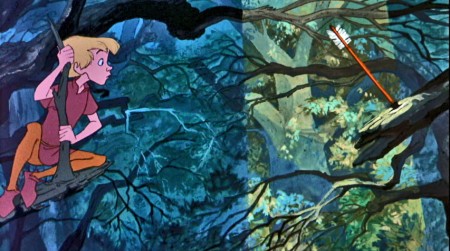
Sq. 1.1 Sc 23 – Animator: Hal King
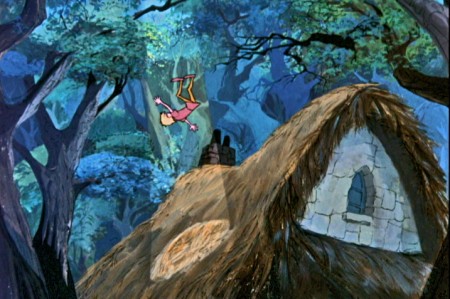
Sq. 1.1 Sc 24 – Animator: Hal King
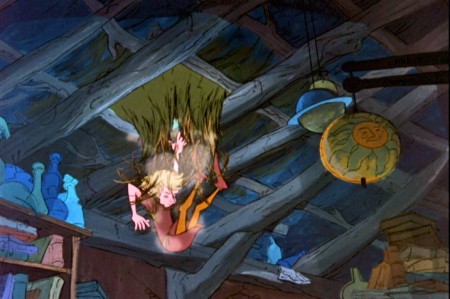
Sq. 002 Sc 29 – Animator: Ollie Johnston
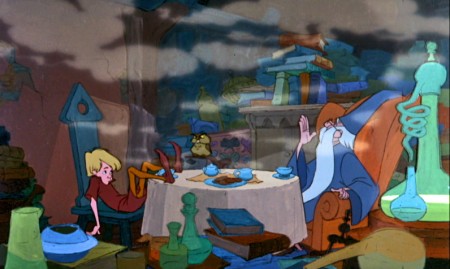
Sq. 002 Sc 30 – Animator: Ollie Johnston
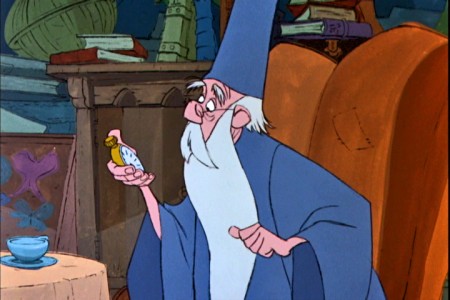
Sq. 002 Sc 31 – Animator: Ollie Johnston
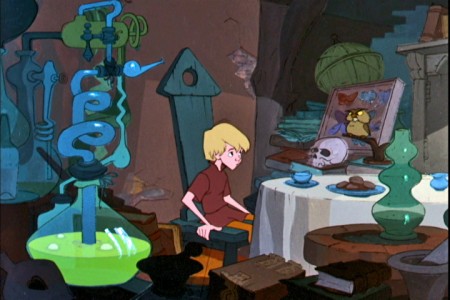
Sq. 002 Sc 32 – Animator: Ollie Johnston
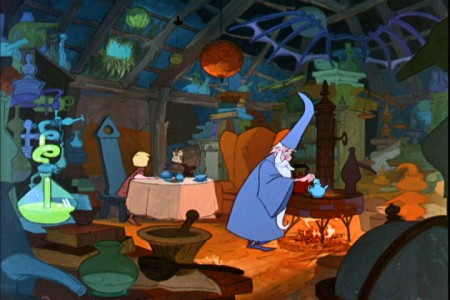
Sq. 002 Sc 33 – Animator: Ollie Johnston
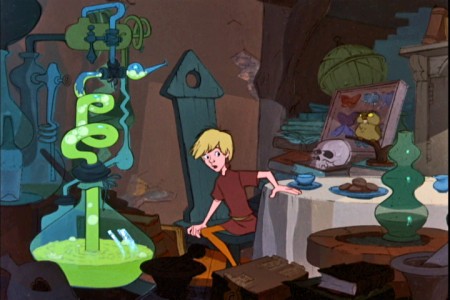
Sq. 002 Sc 34 – Animator: Ollie Johnston
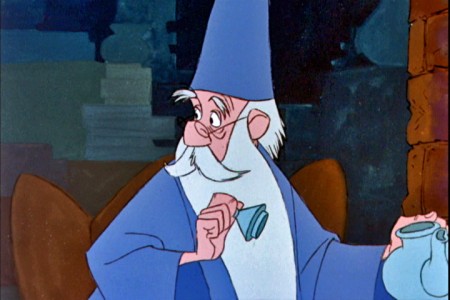
Sq. 002 Sc 35 – Animator: Ollie Johnston
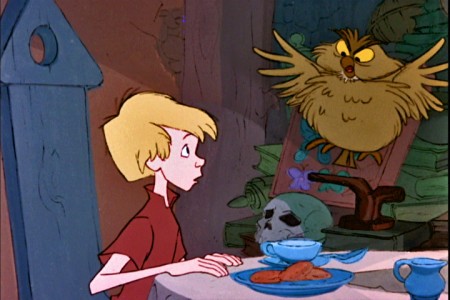
Sq. 002 Sc 36-37 – Animator: Ollie Johnston
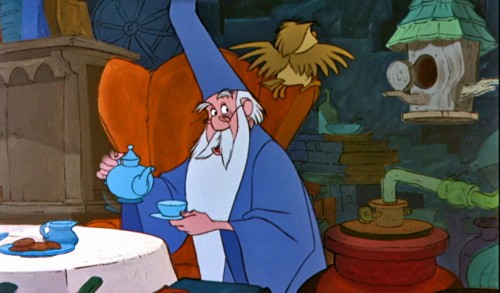
Sq. 002 Sc 38 – Animator: Ollie Johnston
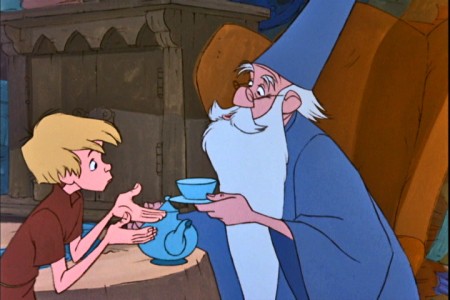
Sq. 002 Sc 39 – Animator: Ollie Johnston
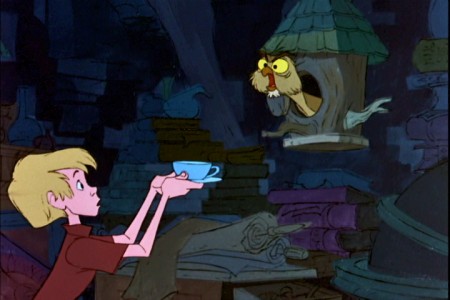
Sq. 002 Sc 40 – Animator: Ollie Johnston
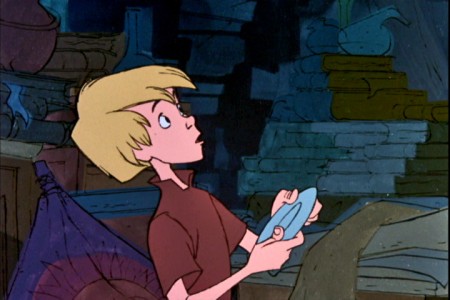
Sq. 002 Sc 41 – Animator: Ollie Johnston
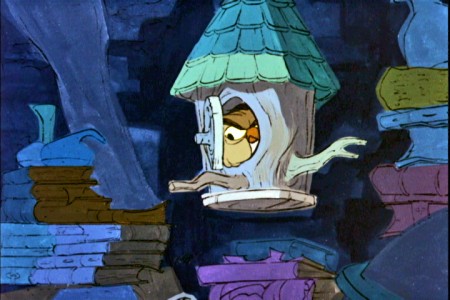
Sq. 002 Sc 42 – Animator: Ollie Johnston
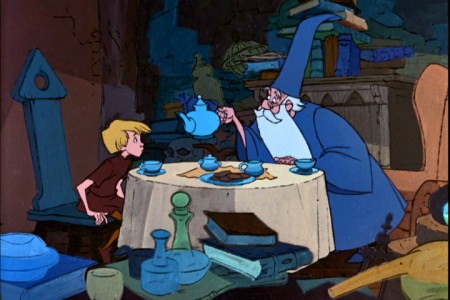
Sq. 002 Sc 43 – Animator: Ollie Johnston
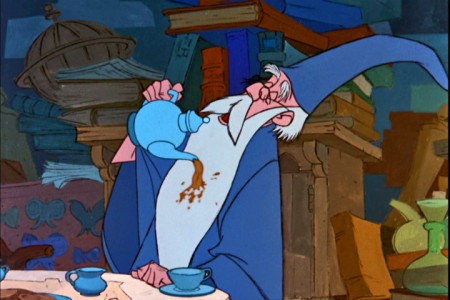
Sq. 002 Sc 44 – Animator: Milt Kahl
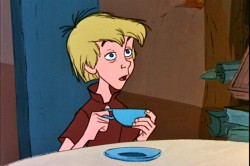
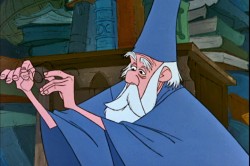
Sq. 002 Sc 45 – Animator : Milt Kahl | Sq. 002 Sc 45.1 – Animator: Milt Kahl
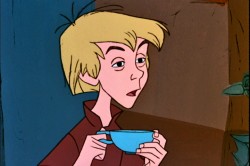
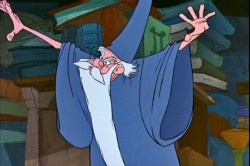
Sq. 002 Sc 45.2 – Animator: Milt Kahl | Sq. 002 Sc 46 – Animator: Milt Kahl
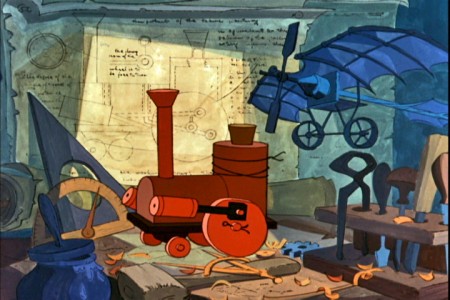
Sq. 002 Sc 47 – Animator: Eric Cleworth
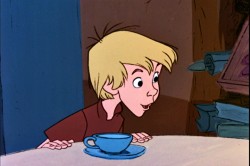
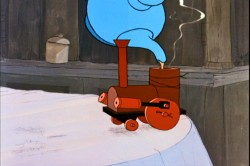
Sq. 002 Sc 48 – Animator: Milt Kahl | Sq. 002 Sc 49 – Animator: Eric Cleworth
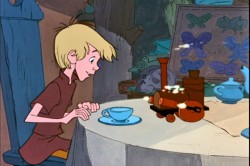
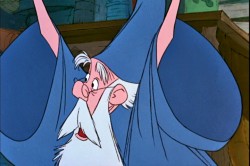
Sq. 002 Sc 50 – Animator: Milt Kahl | Sq. 002 Sc 50.1 – Animator: Milt Kahl
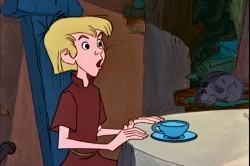
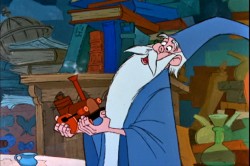
Sq. 002 Sc 50.2 – Animator: Milt Kahl | Sq. 002 Sc 50.3 – Animator: Milt Kahl
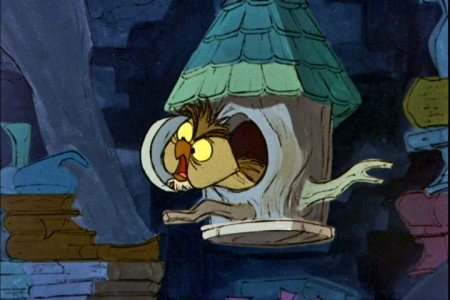
Sq. 002 Sc 50.3 – Animator: Milt Kahl
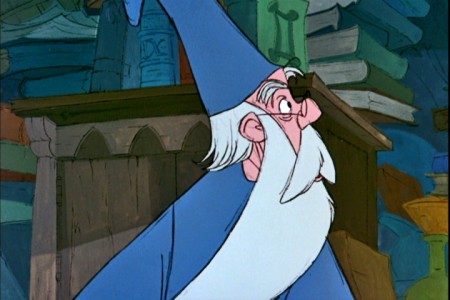
Sq. 002 Sc 50.4 – Animator: Milt Kahl | Sq. 002 Sc 50.5 – Animator: Milt Kahl
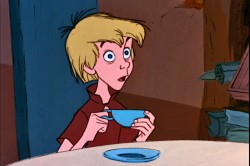
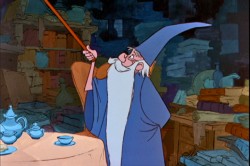
Sq. 002 Sc 50.6 – Animator: Milt Kahl | Sq. 002 Sc 51 – Animator: Milt Kahl
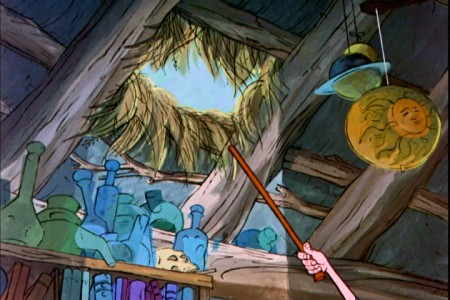
Sq. 002 Sc 52 – Animator: Milt Kahl
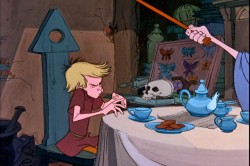
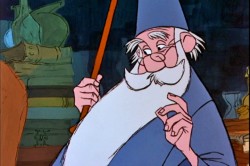
Sq. 002 Sc 52.1 – Animator: Milt Kahl | Sq. 002 Sc 53 – Animator: Milt Kahl
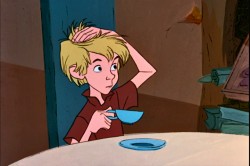
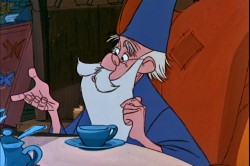
Sq. 002 Sc 101 – Animator: Milt Kahl | Sq. 002 Sc 102 – Animator: Milt Kahl
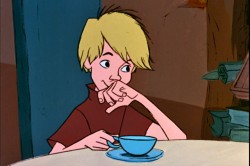
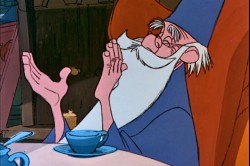
Sq. 002 Sc 103 – Animator: Milt Kahl | Sq. 002 Sc 104 – Animator: Milt Kahl
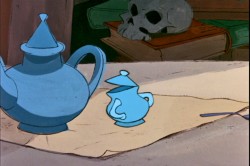
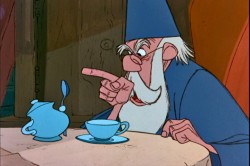
Sq. 002 Sc 105 – Animator: Les Clark | Sq. 002 Sc 105.1 – Animator: Milt Kahl
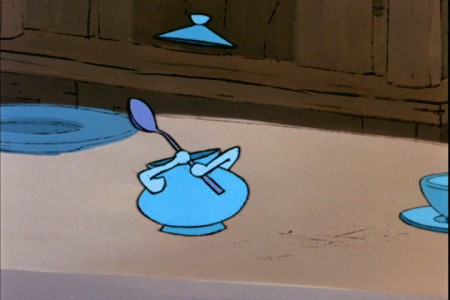
Sq. 002 Sc 105.2 – Animator: Les Clark
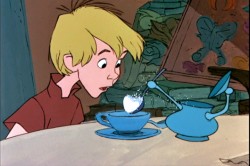
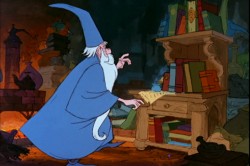
Sq. 002 Sc 106 – Animator: Milt Kahl | Sq. 002 Sc 107 – Animator: Milt Kahl
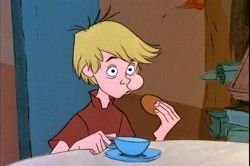
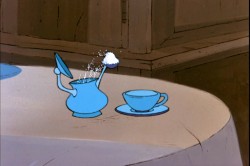
Sq. 002 Sc 108 – Animator: Milt Kahl | Sq. 002 Sc 109 – Animator: Les Clark
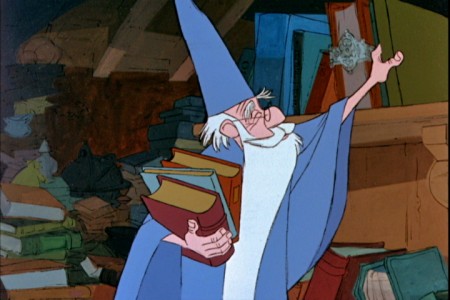
Sq. 002 Sc 110 – Animator: Milt Kahl
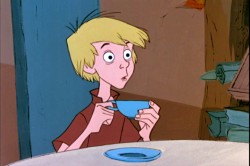
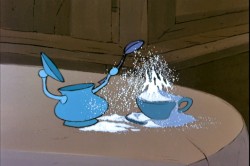
Sq. 002 Sc 111 – Animator: Milt Kahl | Sq. 002 Sc 112 – Animator: Les Clark
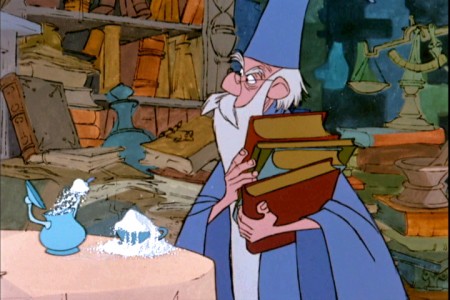
Sq. 002 Sc 113 – Animator: Milt Kahl | Sq. 002 Sc 113.1 – Animator: Milt Kahl
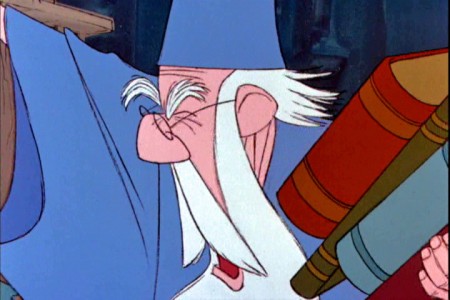
Sq. 002 Sc 113.2 – Animator: Milt Kahl

Sq. 002 Sc 114 – Animator: Les Clark
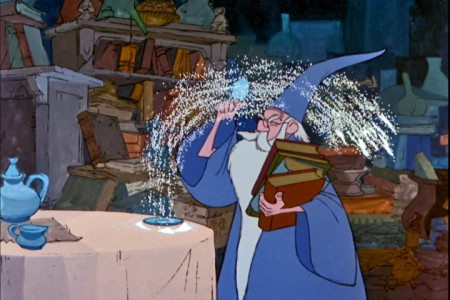
Sq. 002 Sc 115 – Animator: Milt Kahl
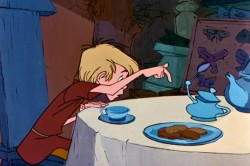
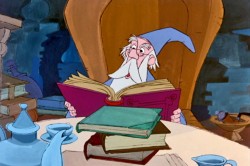
Sq. 002 Sc 116 – Animator: Milt Kahl | Sq. 002 Sc 117 – Animator: Milt Kahl
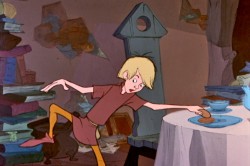
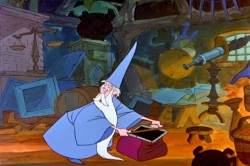
Sq. 002 Sc 119 – Animator: Milt Kahl | Sq. 002 Sc 122 – Animator: Milt Kahl
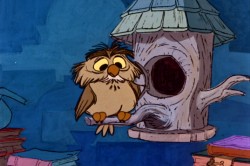
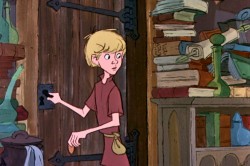
Sq. 002 Sc 123 – Animator: John Lounsbery | Sq. 002 Sc 124 – Animator: Milt Kahl
I’ll continue with the song sequence (Higitus Figitus) tomorrow.
Disney &Frame Grabs 12 Jan 2009 09:09 am
Witch
- It’s not always easy to kill a witch. This sequence from Snow White couldn’t be designed better. It’s short, it’s tense, it’s a tight sequence that handily does its job. The witch is killed in record time. Today, the sequence would be dragged out for half the length of the film.
Some of these drawings are great.
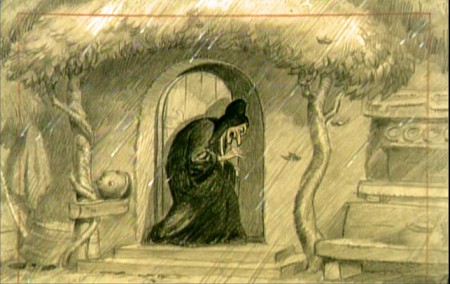 1
1(Click any image to enlarge.)
